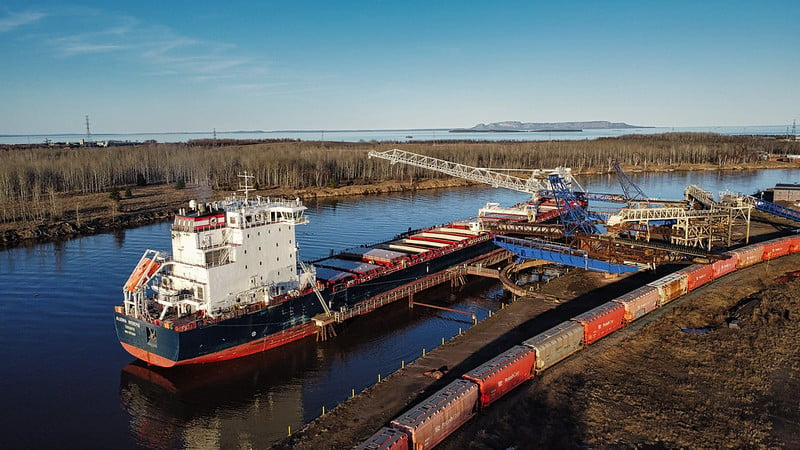 Great Lakes-St. Lawrence shipping:
Great Lakes-St. Lawrence shipping: U.S. Great Lakes shipping reports mixed results; signs for optimism
U.S. Great Lakes ports reported mixed results for the start of the spring shipping season, with gains and losses heavily tied to global trading conditions and Lake Superior ice-breaking resources. U.S. grain exports, steel imports, road salt, and containerized goods were strong performers.
“Inadequate ice-breaking resources in Lake Superior had a major impact on cargo shipments out of the port of Duluth-Superior, which underlines how much we need new and improved capacity for the U.S. Coast Guard icebreaking fleet,” says Bruce Burrows, president and CEO of the Chamber of Marine Commerce. “On a more positive note, grain exports from U.S. ports were in strong demand along with shipments of salt, steel, and containers. We expect that the demand for different cargo segments will continue to be impacted by fluctuating prices and trade flows related to global supply chain issues and the Russia/Ukraine conflict.”
Overall cargo shipments (from March 22 to April 30) via the St. Lawrence Seaway totaled 3.5 million metric tons, down by 18 percent compared to the same period in 2021. Iron ore volumes were down 23 percent. Year-to-date U.S. grain shipments via the Seaway totaled 176,000 metric tons, up 175 percent compared to 2021. Road salt shipments were also up 21 percent, as Canadian mines delivered to cities throughout the bi-national region.
The Port of Toledo was off to a good start in 2022. Through April, 78 vessels have already called upon the Port and tonnage is up nearly 11 percent over the same period in 2021. Grain, salt, coal, and liquid bulk are all outpacing 2021 totals. “While it is early in the season, there are signs that 2022 will be successful,” said Joseph Cappel, VP of Business Development for the Toledo-Lucas County Port Authority. “Grain and fertilizer are expected to be big movers in 2022 as trade patterns and pricing continues to fluctuate based on various global happenings. If our staple commodities like coal, iron ore, and other dry bulk commodities remain consistent, we will have a strong year.”
The Port of Cleveland has experienced a very strong start to the 2022 season in its general cargo operation. April tonnage more than doubled its total tonnage from April 2021. “Our container numbers have also increased dramatically due to the addition of Doornekamp’s Peyton Lynn C to the Spliethoff service last September,” said David Gutheil, Chief Commercial Officer at the Port of Cleveland. “Export customers are now jumping on board due to shortages of containers and vessel space at coastal ports. We are very close to completing the first phase of a very large infrastructure project which will improve the efficiency of the movement of general cargo throughout the Port. This project will be completed in its entirety late first quarter of 2023.”
Hampered by Great Lakes icebreaking challenges and a slower-than-normal start for the American lake freighter fleet, total tonnage through the Port of Duluth-Superior reached only 2.43 million short tons in April 2022. Combined with an icy March in which only three ships called on the port, overall tonnage through April 30 trailed last year’s pace and the five-season average by 38 percent and 27 percent, respectively.
Iron ore, the port’s top cargo by tonnage, neared 1.6 million short tons through April. This represented a 42 percent dip from the 2021 pace and a 34 percent drop compared to the five-season average. Each of the port’s major cargo categories finished April behind the 2021 pace with the exception of grain and salt.
Outbound grain shipments comprised of wheat and beet pulp pellets totaled 148,620 short tons through April, nearly doubling the 2021 pace and exceeding the five-season average by 24 percent. Almost two-thirds of the Duluth-Superior grain float sailed through the Great Lakes-St. Lawrence Seaway System as export commerce.
Inbound salt deliveries to Duluth-Superior topped 81,000 short tons in April, more than doubling the April 2021 total and the five-season average.
“Winter lingered a bit too long this year, which made March and most of April a tough slog for Coast Guard icebreakers and the freighters that depend on them for support to power through those conditions,” said Deb DeLuca, executive director of the Duluth Seaway Port Authority. “We started to see an uptick in vessel traffic later in the month, as the ice situation improved, but it’s still hard to predict the tenor of 2022. Unusual factors continue to affect the world of cargo transportation, including ongoing global supply chain delays and the situation in Ukraine. That instability keeps everyone guessing, but there’s still reason for optimism that it’ll be a good season in the Port of Duluth-Superior.”









